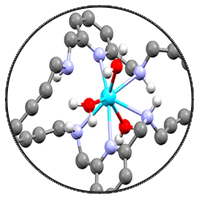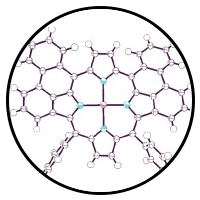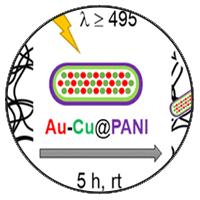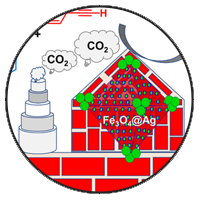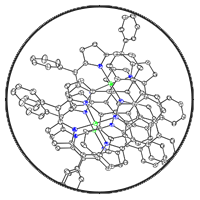Molecular Attack of Solid Tumors and Plaques
We build natural product inspired metal-enediyne (Metalloenediyne) complexes where the metal center mimics the trigger unit found in synthetically very complex natural products. By de novo designing inorganic ligands with alternating triple and double bonds, we mirror the diradical forming reactions of the potent enediyne natural products of which 11/30 are in phase 3 clinical trials.
We build natural product inspired metal-enediyne (Metalloenediyne) complexes where the metal center mimics the trigger unit found in synthetically very complex natural products. By de novo designing inorganic ligands with alternating triple and double bonds, we mirror the diradical forming reactions of the potent enediyne natural products of which 11/30 are in phase 3 clinical trials.
Near-Infrared Absorbing Chromophores for Medicine and Solar Energy Utilization
Molecular frameworks that absorb light in the near-infrared (NIR) region of the spectrum (NIR-I: 700–1000 nm; NIR-II: 1000–1700 nm) have considerable interest in applications related to medicine due to NIR light penetration through soft tissue for imaging and therapeutic applications. Molecules of this type are also of interest for photo-mimetic energy conversion approaches and can take advantage of the solar flux of NIR photons.
Molecular frameworks that absorb light in the near-infrared (NIR) region of the spectrum (NIR-I: 700–1000 nm; NIR-II: 1000–1700 nm) have considerable interest in applications related to medicine due to NIR light penetration through soft tissue for imaging and therapeutic applications. Molecules of this type are also of interest for photo-mimetic energy conversion approaches and can take advantage of the solar flux of NIR photons.
Plasmonic Nanomaterials for Antibiotic Resistance, Clots, and Biofilms
Plasmonic nanomaterials have tunable absorption resonances that can be used to raise the local surface temperature of the material. We use this property to activate biopolymer-dissolving radical reactions in order to clear antibiotic resistant bacteria, unwanted blood clots and treatment defeating biofilms.
Plasmonic nanomaterials have tunable absorption resonances that can be used to raise the local surface temperature of the material. We use this property to activate biopolymer-dissolving radical reactions in order to clear antibiotic resistant bacteria, unwanted blood clots and treatment defeating biofilms.
Hybrid Nanomaterials for Environmental and Chemical Catalysis
Many multistep catalytic reactions rely on consecutive substrate-catalyst cycles where the nature of the catalysts in each step are complementary. To this end, we have combined Lewis acid metal-oxide hosts with noble elements to take advantage of the unique reactivity of each functional metal unit. This allows tandem reactions to be completed in one pot for reactions such as atmospheric CO2 incorporation into substrates in a biomimetic approach similar to the enzyme Rubisco.
Many multistep catalytic reactions rely on consecutive substrate-catalyst cycles where the nature of the catalysts in each step are complementary. To this end, we have combined Lewis acid metal-oxide hosts with noble elements to take advantage of the unique reactivity of each functional metal unit. This allows tandem reactions to be completed in one pot for reactions such as atmospheric CO2 incorporation into substrates in a biomimetic approach similar to the enzyme Rubisco.
Photothermal T-Jump Catalysis and Spectroscopy
Photothermal T-Jump Catalysis and Spectroscopy Reaction mechanisms, especially those that rely on bond changes or structural rearrangements can be monitored in real time using low temperature trapping and time-resolved spectroscopic methods such as transient absorption or luminescence lifetime. Molecular or material catalysts can be temperature jumped to activate substrate-catalyst bond forming steps and monitored using changes in substrate bonding. Catalyst temperatures during the photolysis pulse can also be measured using a temperature-dependent luminescence calibration curve for doped molecular thermometers. We use these methods to perform high barrier reactions on hot catalyst surfaces and probe individual step reaction kinetics using ultrafast laser spectroscopic methods.
Photothermal T-Jump Catalysis and Spectroscopy Reaction mechanisms, especially those that rely on bond changes or structural rearrangements can be monitored in real time using low temperature trapping and time-resolved spectroscopic methods such as transient absorption or luminescence lifetime. Molecular or material catalysts can be temperature jumped to activate substrate-catalyst bond forming steps and monitored using changes in substrate bonding. Catalyst temperatures during the photolysis pulse can also be measured using a temperature-dependent luminescence calibration curve for doped molecular thermometers. We use these methods to perform high barrier reactions on hot catalyst surfaces and probe individual step reaction kinetics using ultrafast laser spectroscopic methods.
Даркнет ссылка на Mega сайт – лучшая онион площадка в РФ!

